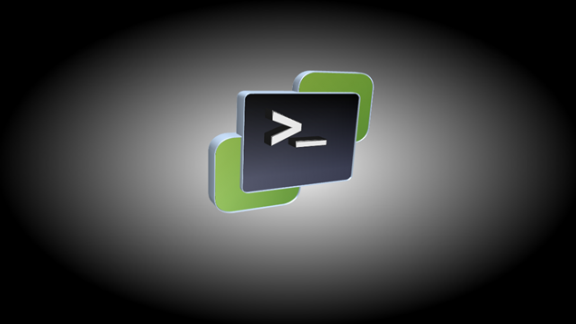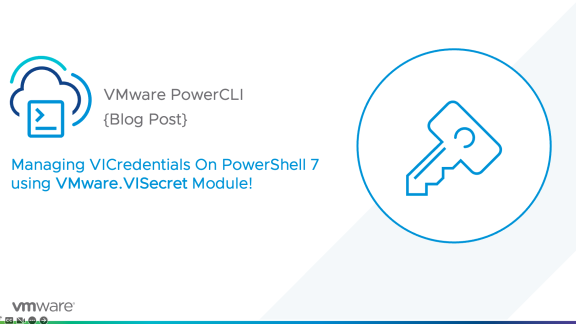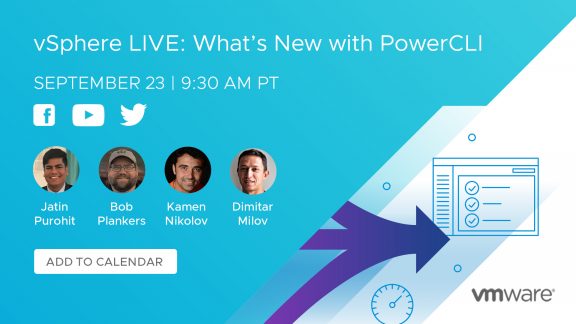The days are ticking away until VMworld Europe, but we have some exciting news that we just couldn’t keep quiet about! PowerCLI version 11.5.0 is here and it is a huge release! More than 20 cmdlets have been added. There are new properties available for the objects we all know and love, one of which has been requested for years. A big update for the VMC module, support for Horizon 7.10.0, and so much more.
PowerCLI 11.5.0 comes with the following updates:
- Added cmdlets for Content Library management
- Added cmdlets for vCenter alarm management
- Added cmdlets for VMware Cloud on AWS SDDC management
- Updated Get-*Service output
- Updated New-VM parameters for networking
- Updated performance for Tag based operations
- Updated properties of Virtual Machine object
- Updated support for Horizon 7.10.0
- Updated support for HCX migration types
Let’s dig in on some of these updates!
Content Library Management Update
Content Library’s features and capabilities have been going through some impressive updates over the last few versions of vSphere. It was one of the first services available through the vSphere Automation (REST) API and has maintained a steady stream of improvements. The latest update added some long-awaited support for templates! PowerCLI is improving the management of the Content Library with eight new cmdlets!
The new cmdlets for Content Library management are as follows:
- New-ContentLibraryItem
- Set-ContentLibraryItem
- Remove-ContentLibraryItem
- Export-ContentLibraryItem
- New-ContentLibrary
- Set-ContentLibrary
- Get-ContentLibrary
- Remove-ContentLibrary
Here’s a brief example of viewing the available Content Libraries and the contents within a specified Content Library.
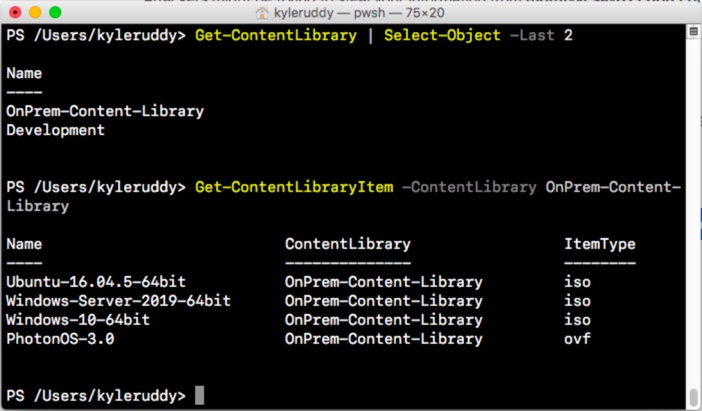
Look for a blog to be released shortly to dive deeper in to the use of these cmdlets!
vCenter Alarm Management Update
Managing vCenter alarms always comes up as one of those things that could be improved when using PowerCLI. There’s a solid set of alarm-based cmdlets which already exist. However, as evidenced by a PowerCLI session at VMworld in 2017 where we dug into some examples only available by the API, those cmdlets didn’t give quite give us everything we needed. PowerCLI 11.5 adds 6 new cmdlets and 3 updated cmdlets to help manage alarm definitions, create alarm triggers, and pull information about available event types and metrics.
These new cmdlets are as follows:
- New-AlarmDefinition
- Remove-AlarmDefinition
- New-AlarmTrigger
- Get-AlarmTrigger
- Get-EventType
- Get-Metric
The updated cmdlets are as follows:
- New-AlarmAction
- New-AlarmActionTrigger
- Set-AlarmDefinition
Here’s a sneak peak at these new cmdlets in action, creating a new vCenter alarm definition:

More details on these new vCenter alarm management cmdlets will be released in future blog post shortly.
VMware Cloud on AWS Module Update
The module for managing VMware Cloud on AWS (VMC) is one of PowerCLI’s newest modules. Initially it was released as a low-level module, which interacted directly with the available VMC APIs. As of PowerCLI 11.5, the VMC module introduces eight new cmdlets to make the management process easier. There’s a cmdlet to easily retrieve high-level information about our SDDCs. We can deploy an SDDC in a single command, down from the 20+ lines it took before. There are also cmdlets to streamline the process of retrieving information about our AWS linked accounts!
The new cmdlets are as follows:
- Get-VmcSddc
- Set-VmcSddc
- New-VmcSddc
- Remove-VmcSddc
- Add-VmcSddcHost
- Remove-VmcSddcHost
- Get-AwsAccount
- Get-AwsVpcSubnet
Here’s a quick example of how we can compress all those lines of code to deploy and view an SDDC down to, essentially, two lines:
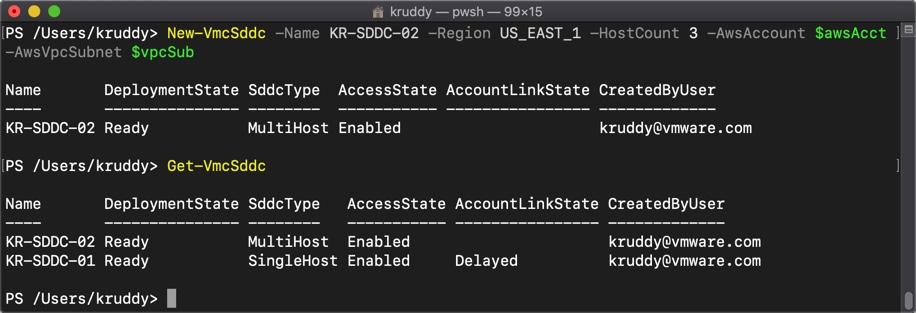
For more details on these new VMC cmdlets, see the following blog: What’s New with the VMware Cloud on AWS Module
VMware Core Module Update
The Core module received a handful of upgrades outside of just the new cmdlets for Content Library and vCenter alarms.
The usage of tags within vSphere environments continues to steadily increase, as well as requests to make the management of those tags more performant. Previously, as of PowerCLI 11.3, the ability to perform batch operations was added. PowerCLI 11.5 builds on that and adds some additional, general, performance improvements to several cmdlets. The Get-Tag cmdlet and Tag parameter for Get-VM have both been updated, as well as Get/Remove-TagAssignment.
There are a couple highly requested updates for some of the standard VM cmdlets too! The ability to configure a new VM’s portgroup, when deploying from template, has been added through the usage of either NetworkName or Portgroup parameters when using New-VM. As of vSphere 6.7, there’s been a new property of VirtualMachine vSphere objects called CreateDate. As of PowerCLI 11.5, the VirtualMachine .Net object now also has a CreateDate property!

Note: Only vSphere 6.7 environments and newer support this property. On vSphere 6.5 and older environments, the property may be blank. An additional caveat, this property is also only supported on VMs which have been created since that environment was on vSphere 6.7 or newer. VMs that have been migrated from older environments will show an older date, generally 1/1/70 12:00:00 AM.
Summary
PowerCLI 11.5.0 has been released and there are tons of new updates! There are more than 20 new cmdlets and 9 cmdlets which have been improved. Support has been added for Horizon 7.10.0 as well as two new migrations types for HCX, Replication Assisted vMotion (RAV) and OS Assisted Migration (OSAM). Plus, when you’re working with a service’s underlying API service, the listing of available services has been updated for easier viewing. The third release of PowerCLI is one you’ll want to update to today!
For more information on changes made in VMware PowerCLI 11.5.0, including improvements, security enhancements, and deprecated features, see the VMware PowerCLI Change Log. For more information on specific product features, see the VMware PowerCLI 11.5.0 User’s Guide. For more information on specific cmdlets, see the VMware PowerCLI 11.5.0 Cmdlet Reference.
Remember, updating your PowerCLI modules is now as easy as:
|
1 |
Update-Module VMware.PowerCLI |

Let us know in the comments what you’re looking forward to most!
